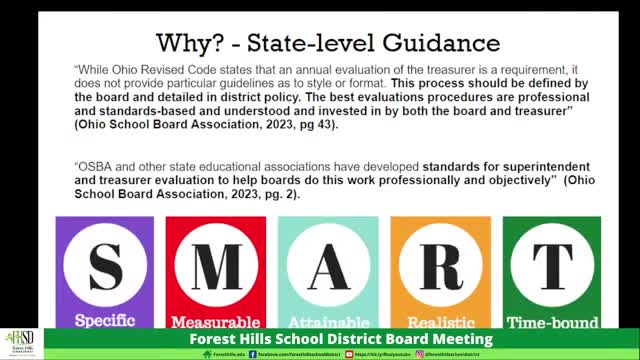School Board Faces Crisis Over Evaluation Standards
September 25, 2024 | Forest Hills Local, School Districts, Ohio
This article was created by AI summarizing key points discussed. AI makes mistakes, so for full details and context, please refer to the video of the full meeting. Please report any errors so we can fix them. Report an error »

In a recent Forest Hills School Board meeting, members engaged in a heated discussion regarding the evaluation processes for the district's superintendent and treasurer. The conversation highlighted significant concerns about the current evaluation methods, which some board members deemed inadequate and subjective.
Board member Jason emphasized the necessity of a rigorous, research-based evaluation system, referencing guidance from the Ohio School Board Association (OSBA). He pointed out that while Ohio law mandates an evaluation plan, it does not specify its structure, leaving room for interpretation. He advocated for a collaborative approach to developing evaluation criteria that align with job descriptions and district goals, stressing the importance of using objective data to inform decisions about employee performance.
The board's historical reliance on a comprehensive evaluation tool was also discussed. Previous boards had successfully implemented a research-aligned evaluation system, supported by a consultant who helped establish effective assessment practices. However, current evaluations were criticized for being overly focused on subjective measures, such as personal disposition, rather than objective performance indicators.
Concerns were raised about the potential consequences of making personnel decisions without a solid evaluation framework. Board members noted that replacing key positions like the treasurer could be challenging, citing recent difficulties faced by neighboring districts in finding qualified candidates. The discussion underscored the financial implications of hiring a new treasurer, especially if the decision was made without adequate data to justify it.
As the meeting progressed, tensions escalated, with board members expressing frustration over perceived dysfunction within the group. Some members defended the existing evaluation system, while others called for a shift towards a more objective, evidence-based approach. The debate highlighted a broader issue of governance and collaboration within the board, as members struggled to align on the best path forward for employee evaluations.
Ultimately, the board agreed on the need for a public discussion to explore solutions for establishing a more effective evaluation process. The proposed five-step plan aims to develop a standards-based job description, set annual goals, and implement a comprehensive evaluation system that incorporates multiple data sources. The board's commitment to improving evaluation practices reflects a desire to enhance accountability and transparency in the district's leadership.
Board member Jason emphasized the necessity of a rigorous, research-based evaluation system, referencing guidance from the Ohio School Board Association (OSBA). He pointed out that while Ohio law mandates an evaluation plan, it does not specify its structure, leaving room for interpretation. He advocated for a collaborative approach to developing evaluation criteria that align with job descriptions and district goals, stressing the importance of using objective data to inform decisions about employee performance.
The board's historical reliance on a comprehensive evaluation tool was also discussed. Previous boards had successfully implemented a research-aligned evaluation system, supported by a consultant who helped establish effective assessment practices. However, current evaluations were criticized for being overly focused on subjective measures, such as personal disposition, rather than objective performance indicators.
Concerns were raised about the potential consequences of making personnel decisions without a solid evaluation framework. Board members noted that replacing key positions like the treasurer could be challenging, citing recent difficulties faced by neighboring districts in finding qualified candidates. The discussion underscored the financial implications of hiring a new treasurer, especially if the decision was made without adequate data to justify it.
As the meeting progressed, tensions escalated, with board members expressing frustration over perceived dysfunction within the group. Some members defended the existing evaluation system, while others called for a shift towards a more objective, evidence-based approach. The debate highlighted a broader issue of governance and collaboration within the board, as members struggled to align on the best path forward for employee evaluations.
Ultimately, the board agreed on the need for a public discussion to explore solutions for establishing a more effective evaluation process. The proposed five-step plan aims to develop a standards-based job description, set annual goals, and implement a comprehensive evaluation system that incorporates multiple data sources. The board's commitment to improving evaluation practices reflects a desire to enhance accountability and transparency in the district's leadership.
View full meeting
This article is based on a recent meeting—watch the full video and explore the complete transcript for deeper insights into the discussion.
View full meeting
